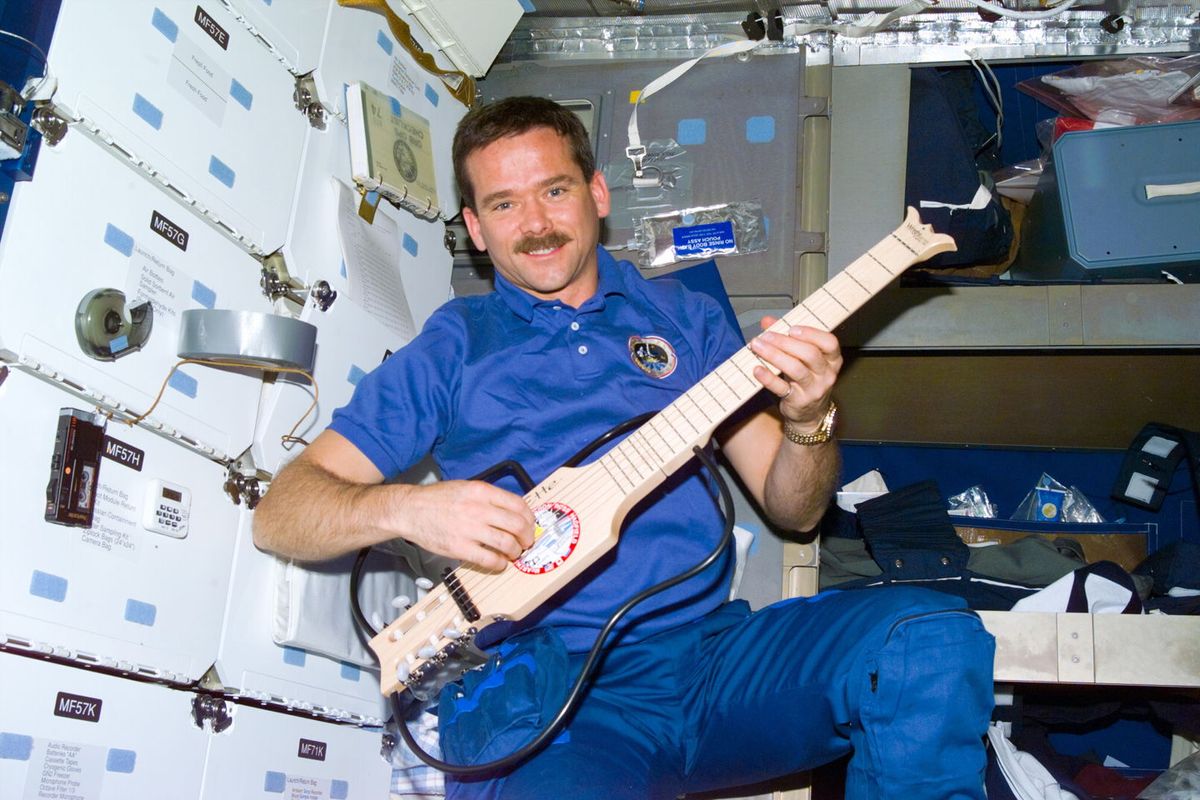Astronaut and Rocker to Premiere Space-Earth Duet Friday

A song inspired by space will become the first tune to premiere via a ground-and-orbit duet.
Canadian astronaut Chris Hadfield will collaborate with Canadian musician Ed Robertson, best known as a member of the Grammy Award-winning Barenaked Ladies group, to release the first duet to premiere from space and Earth simultaneously.
On Friday (Feb. 8), Hadfield will perform in space, and Robertson will sing with a youth choir in Toronto.
The tune, called "I.S.S. (Is Somebody Singing)," hints at Hadfield's current home on the International Space Station in the initials of the title. That was deliberate, the collaborators say.
"I wanted to impart some of the wonder that Chris has imparted to me," Robertson wrote in a blog for the Canadian Broadcasting Corp., the national broadcaster of Canada.
"I wanted it to be a celebration not about the remoteness of space, but about the connectedness of a human being on the I.S.S. who looks down and sees the whole planet in a way that, from our perspective, we don't have the opportunity to."
'Dude, you are a high-functioning individual'
Sign up for the Live Science daily newsletter now
Get the world’s most fascinating discoveries delivered straight to your inbox.
Hadfield, who will command Expedition 35 in March, is an accomplished musician who plays in two astronaut bands. In December, he released thefirst original song recorded on the station: "Jewel of the Night." [See and hear Hadfield's song "Jewel in the Night" (Video)]
Robertson, who describes himself as a long-time friend of Hadfield's, initially planned to write "Is Somebody Singing" with only a little input from the Canadian astronaut. The two first met more than a decade ago when Hadfield offered the popular band a tour of Mission Control.
But when he reached out to Hadfield about the project, Robertson was astonished that the astronaut committed to collaborating on it in 2012, despite being in the middle of training for his five-month space mission.
"I wrote the first verse and chorus, sent it to him, and asked for some technical jargon for the second verse because the first verse was emotional," Robertson wrote. "I asked him to be on the lookout for speeds and weights and a number of revolutions, serial numbers; anything we can use to put some technical data into this song. After about a day and a half he sent me the second verse, and it was poetic and good. I was just like, 'Dude you are a high-functioning individual.'"
Space music
While Robertson and Hadfield will be the first to premiere a song by playing it simultaneously from Earth and space, their performance will not be the first Earth-space duet. That distinction belongs to NASA astronaut Cady Coleman, who collaborated with Jethro Tull's Ian Anderson on the ground to play the band's song "Bourree" over a satellite connection.
That concert, in which Coleman played the flute, took place April 11, 2011, during the space station's Expedition 27 mission. The performance was a celebration of the 50th anniversary of humanity's first spaceflight by Yuri Gagarin on April 12, 1961.
Music is a common pastime for astronauts. If they're not listening to it as they gaze at Earth, they are often creating it themselves.
The first song performed in space was the holiday standard "Jingle Bells," as part of a 1965 Christmas prank by Gemini 6 astronauts Tom Stafford and Wally Schirra.
>Just before playing the song, they joked on the intercom that they could see an object "like a satellite going from north to south, probably in polar orbit … Looks like he might be going to re-enter soon." (They were referring to Santa Claus.)
This story was provided by SPACE.com, a sister site to Live Science. Follow Elizabeth Howell @howellspace, or SPACE.com @Spacedotcom. We're also on Facebook and Google+.

Elizabeth Howell was staff reporter at Space.com between 2022 and 2024 and a regular contributor to Live Science and Space.com between 2012 and 2022. Elizabeth's reporting includes multiple exclusives with the White House, speaking several times with the International Space Station, witnessing five human spaceflight launches on two continents, flying parabolic, working inside a spacesuit, and participating in a simulated Mars mission. Her latest book, "Why Am I Taller?" (ECW Press, 2022) is co-written with astronaut Dave Williams.











